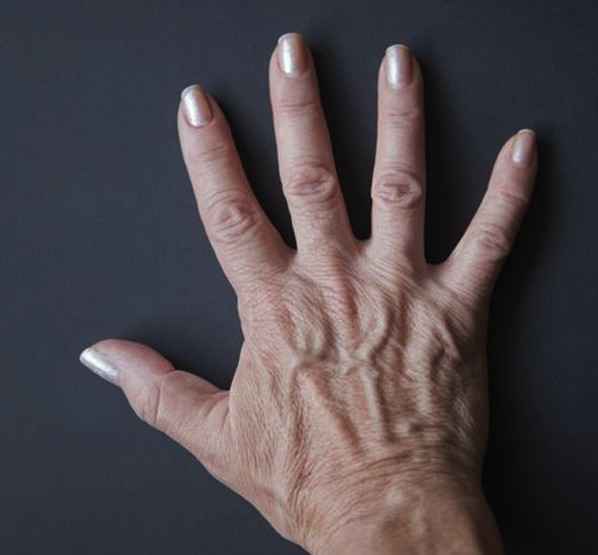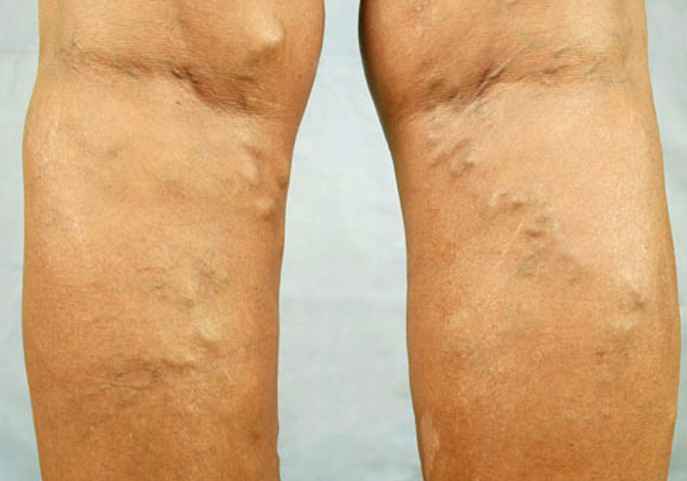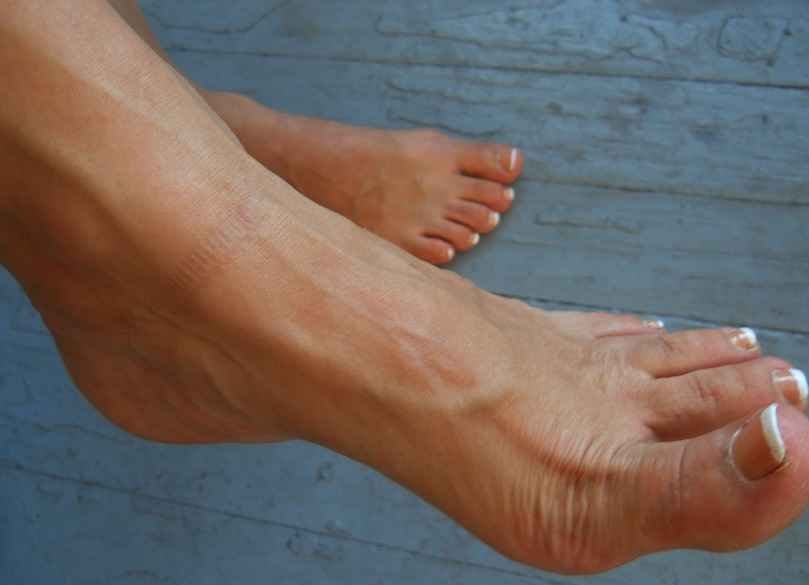Dark Blue Veins on Back of Arms and Side of Body
What are Bulging veins?
In the human body, all the veins have one-way valves that help to keep the circulation of blood in one direction. Muscles contract to act as pump and elastic vein walls push the blood to the heart for recirculation. When the valves don't work properly and allow the blood to pool or accumulate, it results in bulging of veins. In fact, the valves couldn't prevent the backward flow of the blood into the veins and it will begin to pool, causing the vein wall to bulge. This situation leads to the enlargement of the veins, and they become large, distended and unattractive. The patient also feels itchiness or pain in these bulging veins. These veins appear to be bluish. The blue color is mainly due to the deoxygenated blood accumulated in the veins.
The bulging of veins is generally caused by venous insufficiency, obesity, pregnancy, aging, hereditary, overexposure to the sun, chronic constipation, hormonal changes (especially in women) lack of movement and Thrombophlebitis etc. We will discuss the causes in details in the upcoming sections of this article.
What are the Symptoms of Bulging veins?
Arteries help to circulate the blood away from the heart to the rest of the body while the veins take the blood back to the heart from the rest of the body. In majority of the cases, the patient will not feel pain but there are some quite visible symptoms of bulging veins. These include:
Common symptoms
- Veins appearing to be blue or dark purple in color
- Lumpy, twisted and swollen veins (looking like chords in the legs)
- Skin darkening
- Rashes on the skin
- Feeling of heaviness in legs
- Aching legs
- Swollen ankles
- Affected skin becomes itchy, dry and red, a condition known as venous eczema
- Restless legs syndrome
- Appearing of irregular whitish patches on the ankles of patient, a condition known as Atrophie Blanche
- Hardening of the fat just above the ankle, a condition known as lipodermatosclerosis which results in skin shrinking.
Painful and severe symptoms
- Prolonged bleeding from the affected area or vein
- A feel of severe pain or pulling in legs
- Severe pain after standing or sitting for a long period of time
- Sore of the skin or skin ulcers near your ankle
- Numbness in legs
- Cramping, swelling Burning or throbbing in lower legs.
Bulging veins Diagnosis
Diagnosis of bulging veins is an easy task. The doctor will carry out easy steps to identify the characteristics of bulging veins. You'll have to go through a physical examination for the diagnosis. If have any of the above mentioned symptoms, you must visit a vascular surgeon or vascular medicine specialist. These health professionals deal with the issues of blood vessels. You can also visit a dermatologist.
Physical Examination
During the physical examination, the doctor will check your legs while you are in a standing or sitting posture. He or she may also ask for common or severe symptoms of bulging.
Doppler Ultrasound
In this method, a handheld device (transducer) is used. The doctor skims the machine over the skin to find out the blocked valves and faulty veins. It is the same device used to check the fetus development during pregnancy.
Duplex Scanning
It is quite similar to the Doppler and it is used to identify the blood clotting in veins.
Magnetic Resonance Venography
If the duplex test is not providing accurate results, doctor may recommend Angiogram. In this technique, a dye is injected into the veins and it highlights the blocked vessels in the x-ray image.
What causes veins to bulge?
Damaged, blocked or weak valves in veins can result in veins bulging. Well, according to the researchers, there are no define set of causes for bulging veins. However, these may happen due to a number of reasons. These include:
Inheritance
According to the doctors, inherited issues cause some patients to have inefficient valves or have too few valves to work properly.
Varicose or spider veins
Both are common cause of bulging veins. These are normally formed in the feet, inner thigh and leg area; however, you can also find varicose veins in other parts of the body. These can be painful, too. Spider veins are milder as compared to the varicose veins. These usually results in bulging veins on side of head, neck and face; however, you can find them in other body parts, too.
Pregnancy
Pregnancy causes an increased volume of blood in women but decreased flow of blood from legs to the pelvis. Pressure on the veins increases and it becomes tough to push the blood back to the heart promptly. It is natural circulatory flow designed to provide more blood to the fetus for rapid growth but it causes enlarged veins in the legs of pregnant women. These are common in first time or late pregnancy.
The good thing is that the bulginess disappears after 3 to 12 months of the delivery and the veins regain their normal posture.
Aging
When you cross the age of 50, you can experience bulging veins. With the growing age, the vein muscles tend to get weaker and the walls of veins become less elastic. So these muscles can't exert the required pressure to push the blood back to the heart. In the same way, the valves also become weak and start to function poorly. As a result, the blood pool in the veins and causes bulginess.
Thrombophlebitis
It is a situation in which blood clots inside the vein and it results in vein bulging. It usually happens in legs however it is also observed in the arm and neck area. It can affect both the veins on the surface of the skin and the deep veins. In severe conditions, if the blood clot dislodges from the wall of the vein, blood takes it to the lungs of the patient where it can cause a pulmonary embolism. It is a critical condition for the patients which need immediate and proper medical care. Remember, it can stop the circulation of blood in the human body.
Prolonged standing
It is common issue for persons involved in the jobs requiring prolonged standing like receptionists, waiters etc.
Obesity or distended belly
If you're overweight, extra pressure would be exerted on your veins resulting in bulging veins.
Chronic constipation or tumor
Anything that exerts pressure in the abdominal area can cause bulging veins. It may be due to chronic constipation or a tumor.
Menopause
In women, menopause is one of the causes of bulging veins.
Other causes include trauma, injury, enlarged prostate and chronic cough etc.
What causes bulging veins in forehead?

Picture of bulging veins in forehead
Sometimes, veins pop up in the area of forehead. It is mainly due to posture, strain, emotions or other medical issues related to bulging veins. It is generally observed in middle-ages people.
Bulging veins Prevention
Keep your weight under control
As a matter of fact, nobody can change or modify the genes but if you have hereditary issues concerning bulging, you must keep your weight under control to avoid this condition. You can do it by controlling your eating habits and exercise.
Eat food containing fiber
Try to eat high fiber food and wear loose clothes if you have inherited bulging veins issue.
Avoid standing for long period of time
Well, you must avoid standing for long period of time if you have bulging veins issue.
Compression
Your doctor may also advise you to wear compression socks or stocking so that they can artificially exert enough pressure on your veins to make normal pressure. In this way, the blood can easily flow back to the heart. It is usually used in the leg area of patient.
You must follow the above mentioned steps if you have bulging veins or you have inheritance issue of bulging veins.
Risk Factors involved in bulging veins
Following are the risk factors involved in bulging veins:
- Sex
- Genetics
- Age
- Obesity
- Job nature
Complications
Normally, patients experience painful headache, itching and reddishness due to bulging veins. Bulging veins can be caused by a number of factors. If the patient doesn't get proper treatment, he or she can observe various complications and permanent damages. These complications include:
Ulcers
Increased pressure of the blood in the bulging veins can result in long-term fluid buildup in the tissues and it causes ulcer. This type of extreme painful ulcer may result in bulging veins near the ankles of the patient. The skin discolors before the development of ulcer. In such a condition, immediately contact your doctor to prevent further complications.
Bleeding
Patients can observe minor bleeding due to the rupturing of veins near the skin surface. The bulging veins close to the surface burst due to increased pressure of blood. In such a situation, patient must seek immediate medical care.
Blood clotting
Sometimes, the veins suddenly swell. It is due to the formation of blood clot. It results in sudden bulging veins in hand, wrist, legs or arms. It needs immediate medication otherwise it can lead to severe health problems.
Treatment
After identifying the reasons of bulging veins, the doctor may recommend several types of treatment for the bulging veins.
Lifestyle changes
First of all, your doctor may recommend some lifestyle changes to deal with the issue.
For instance, the doctor may recommend alleviating the affected area during rest; wearing compression clothes and doing exercise regularly, putting your feet up frequently or weight lose.
Sclerotherapy
During this procedure, your doctor will inject a solution in the bulging veins. This solution creates scars and closes the circulation within the veins. However, the blood uses other nearby veins to circulate. Within few weeks, the treated veins get healthy.
This process doesn't involve anesthesia and it can be performed in the doctor's office. It may be carried out for more than once. If it is done accurately, it provides 100% results.
Foam Sclerotherapy of Large Veins
In this method, a foam solution is injected into large bulging veins. It is a relatively new method.
Ligation and Stripping
In this procedure, two incisions are made, the first one near the knee or ankle and the second one at the top of the affected vein. The affected vein is removed with the help of a thin wire. The removal of vein doesn't affect the circulation of blood because the large deep veins take care of the large volume of the blood circulation.
The patient recovers within one to four weeks. It doesn't require a hospital stay. It sometimes causes bleeding, bruising or pain and in rare cases, it may result in deep vein thrombosis. Wear compression cloth during recovery period.
Catheter-assisted procedures using laser energy or radiofrequency
In this procedure, the doctor uses a thin tube called catheter. He puts the v into the bulging vein and heats the tip of the catheter with the help of laser or radiofrequency energy. When the doctor pulls out catheter, the heat destroys the vein by collapsing and shutting it. It is good process for the large veins.
Laser treatment
In this process, doctor close off the small affected veins with the help of laser. During this process, strong bursts of light are passed into small veins which cause them to fade and disappear. It doesn't involve cutting or incision.
Endoscopic vein surgery
In critical condition, if other methods fail, the doctor adapts this technique. He will insert a thin video camera into your legs to visualize and close the bulging veins. After that, he will remove the closed veins through small incisions. It is used in patients suffering from ulcer.
Ambulatory phlebectomy (fluh-BEK-tuh-me)
In this method, bulging veins are removed through tiny skin punctures. in this process, the treated area is numbed for a short period of time. It causes small scars that fade away with the passage of time.
Other pain relief medications
There are also some other good products to treat the bulging veins. These include;
- Sweet clover
- Horse chestnut
- Grape (leaves, sap, seed and fruit)
- Butcher's broom
- Apple cider vinegar
- Witch hazel
- Use of essential oils
- Pine bark extracts
- Pot marigold
- Cayenne pepper
- Mud packs
- Gentle massage
Types of bulging veins
There are two main types
- Varicose veins
- Spider veins
These can be further categorized into
- Bulging veins in neck
- Bulging abdominal veins
- Engorged Neck Veins
- Engorged scalp veins
- Jugular vein distention
Pictures of Bulging veins
Take a look at some of these pictures to find out how Bulging veins looks like:

Picture of bulging veins in hands

Picture of Bulging veins in legs

Picture of Bulging veins in arms

Picture of Bulging veins in feets
luncefordinet1986.blogspot.com
Source: https://hellomrdoctor.com/bulging-veins/
0 Response to "Dark Blue Veins on Back of Arms and Side of Body"
Post a Comment